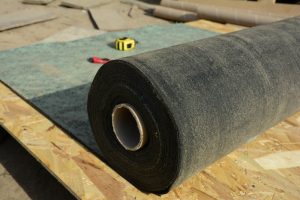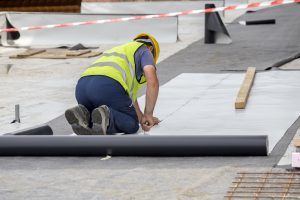Choosing Between Types of Roofing Underlayment With Thunder Bay Roofing
With so many different types of roof underlayment to choose from, picking the right type of roofing underlayment is one of the most critical decisions Maryland homeowners face when protecting their investment from the state’s challenging weather conditions.
At Thunder Bay Roofing, lead contractors Nick Perz and Steven Friedman have extensive experience helping homeowners throughout Edgewater, Annapolis, Arnold, and Bel Air, MD, select the optimal underlayment solution that provides superior protection and exceptional value.
Ready to discover which underlayment type is perfect for your roofing system? Contact Thunder Bay Roofing, your local Edgewater, MD, roofing company at 410-956-7663 for your personalized consultation and expert recommendations!
Why Choose Thunder Bay Roofing for Underlayment Selection
Thunder Bay Roofing’s extensive experience with roofing underlayment ensures that Maryland homeowners receive guidance in selecting materials that provide optimal protection and value. Lead contractors Nick Perz and Steven Friedman personally evaluate every project to recommend the most appropriate roofing underlayment solution for your specific needs and budget requirements.
From our base in Edgewater, our roofing contractors serve homeowners throughout Maryland, including Annapolis, Arnold, Bel Air, and surrounding communities with personal attention that ensures optimal results. Our reputation for excellence and commitment to customer satisfaction make us the trusted choice for Maryland homeowners who demand the best protection for their properties. Call our Edgewater, MD, roofing contractors at 410-956-7663 to learn more about your roofing underlayment options or to book your free consultation.
Asphalt-Saturated Felt (Felt Paper)
One of the oldest and most traditional types of roof underlayment, asphalt-saturated felt underlayment is made from a base of organic materials (often cellulose) saturated with asphalt to enhance water resistance. Asphalt-saturated felt is also commonly known as tar paper. It typically comes in two thicknesses: 15-pound and 30-pound. The 30-pound option is heavier and offers more durability and tear resistance.
While it’s more budget-friendly, this roofing underlayment is less common in modern roofing systems because it doesn’t perform as well in extreme weather conditions or under prolonged moisture exposure compared to synthetic options.
Glass-Fiber Reinforced Felt
A modern variation of traditional felt, glass-fiber-reinforced felt utilizes a fiberglass base instead of organic materials. This results in a stronger, more durable product that lies flatter on the roof deck and resists tearing and wrinkling better than standard felt. It’s a durable upgrade for those who want the familiarity of felt with improved performance.
Rubberized Asphalt Underlayment
Rubberized asphalt underlayments are a premium option known for their superior waterproofing capabilities. They contain higher percentages of asphalt and rubber polymers, giving them a sticky, self-adhering surface that creates a waterproof and watertight seal to the roof deck and around nails and penetrations. This type is ideal for high-risk areas prone to water penetration, such as valleys, eaves, and around chimneys or skylights.
Rubberized asphalt underlayments are designed to withstand high temperatures and offer excellent heat resistance, making them especially suitable for hot climates and metal roofs. They’re also preferred in regions with ice dams or heavy snow loads.
Synthetic Underlayments
There are many synthetic underlayments available, each with unique features, rapidly becoming the most popular choice in modern roofing systems. Synthetic underlayments are typically made from woven or spun polypropylene or polyethylene. It’s lightweight, highly durable, and tear-resistant, and offers excellent UV resistance for prolonged exposure during construction, helping protect against UV rays. Many synthetic products also have non-slip surfaces for better worker safety.
Unlike felt, synthetic underlayments don’t absorb water and lay flatter on the roof deck, reducing wrinkling and potential issues with shingle installation. While more expensive than felt, synthetic underlayment provides long-term value due to its superior performance and longevity.
Self-Adhering Membranes (Peel-and-Stick)
Self-adhering membranes are a type of roofing underlayment that bonds directly to the roof deck without the need for mechanical fasteners. They are typically composed of a rubberized asphalt or butyl-based adhesive layer topped with a polymer film. This makes them excellent for waterproofing and especially effective in sealing around nail penetrations.
Self-adhering membranes are especially beneficial for commercial roofs due to their superior sealing properties. They are also highly effective in preventing minor leaks, which can lead to larger issues if left unaddressed.
High-Temperature Underlayment
Designed specifically for use with metal roofing materials or environments with extreme heat, high-temperature underlayment can withstand continuous temperatures often above 250°F. These materials are typically made with fiberglass or polyester mats combined with high-temperature asphalt or other polymer blends.
High-temperature underlayments are especially important in hot climates to prevent premature deterioration caused by prolonged sun exposure and elevated temperatures. This type ensures the underlayment won’t deteriorate prematurely or lead to roof failures under intense thermal conditions.
Non-Bitumen Synthetic Underlayment
Non-bitumen synthetic underlayment is a subcategory of synthetic underlayment that does not contain bitumen or asphalt products. It’s engineered for superior strength, breathability, and environmental resistance, often using advanced polymers. Some varieties are designed to allow moisture vapor to escape from the roof deck while keeping water out, making them ideal for ventilated roof systems. These are more eco-friendly and often recyclable, offering performance with sustainability in mind.



